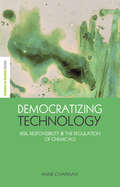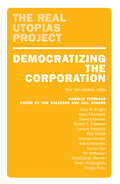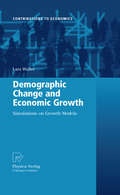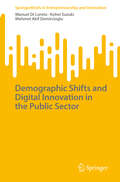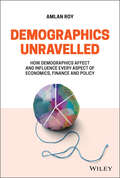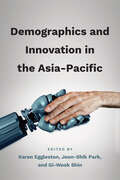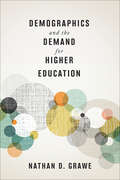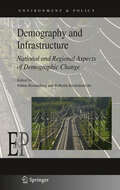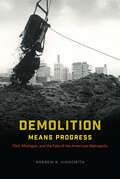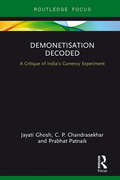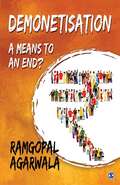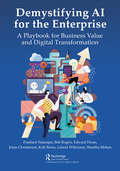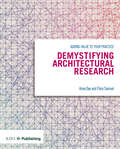- Table View
- List View
Democratizing Technology: Leading Sustainable and Scalable Change
by John Elkington Pamela HartiganIn this chapter, the authors study four clusters of entrepreneurs whose technological ventures will improve the future for a growing proportion of the burgeoning human population.
Democratizing Technology: Risk, Responsibility and the Regulation of Chemicals (The Earthscan Science in Society Series)
by Anne ChapmanDemocratizing Technology provides a much-needed fresh perspective on the regulation of chemicals, and an important contribution to green thinking about technology.Caroline Lucas, Green Party MEP. This book is an excellent critique of the current risk-based approach to technology. By exploring the philosophical underpinnings and the practical applications of current policy on science and technology, Chapman exposes the serious flaws in allowing economic considerations to dominate the agenda in this area. Her proposals for reform are expertly constructed and deserve urgent and serious consideration by policy-makers.Dr Stuart Parkinson, Executive Director, Scientists for Global Responsibility. In this important book Anne Chapman argues that decisions about technology should answer a republican question: what kind of public world should we create through technology? Democratizing Technology deserves to be read widely. John ONeill, Professor of Political Economy, University of Manchester, UK A welcome addition to the new, more empirical and applied literature in philosophy of technology. This book will be essential reading for a variety of scholars and for the general reader intent on understanding, and criticizing, our chemically made world.Andrew Light, Interim Director, Program on the Environment, University of Washington, US What is technology? How do humans use it to build and modify the world? What are the relationships between technology, science, economics and democratic governance? What, if any, are our ethical and political responsibilities and choices in how we develop, deploy and control technology in democratic states? Democratizing Technology sets out to answer these questions. Focusing on the most widespread and pervasive technology - chemicals - this groundbreaking volume peels apart the critical technology debate to look at the relationship between humans, technology and the biological world. Attention is given to the immensely important new regulations, REACH (Registration, Evaluation, Authorization and restriction of Chemicals), the EUs largest ever legal framework, discussing the problems that are likely to occur in REACHs reliance on risk assessment methods and suggesting an alternative way forward for the regulation of chemicals. Providing much-needed clarity and insight into the heart of key debates in science and technology, risk analysis and mitigation, and domestic and international law, this volume arrives as a breath of fresh air.
Democratizing the Corporation: The Bicameral Firm and Beyond
by Joel Rogers Isabelle Ferreras Tom MallesonWorker representation is the first step toward democratizing the economyAlthough contemporary Western societies refer to themselves as &“democratic,&” the bulk of the population spend much of their lives in workplaces that have more in common with tyranny. Gigantic corporations such as Amazon, Meta, Exxon, and Walmart are among the richest and most powerful institutions in the world yet accountable to no one but their shareholders. The undemocratic nature of conventional firms generates profound problems across society, hurting more than just the workplace and contributing to environmental destruction and spiraling inequality.Against this backdrop, Isabelle Ferreras proposes a radical but realistic plan to democratize the private firm. She suggests that all large firms should be bicamerally governed, with a chamber of worker representatives sharing equal governance power with the standard board representing owners. In response to this proposal, twelve leading experts on corporate behavior from multiple disciplines consider its attractiveness, viability, and achievability as a &“real utopian&” proposal to strengthen democracy in our time.
Democratizing the Economics Debate: Pluralism and Research Evaluation (Young Feltrinelli Prize in the Moral Sciences)
by Carlo D'IppolitiMore than a decade since the global financial crisis, economics does not exhibit signs of significant change. Mainstream economists act on an idealized image of science, which includes the convergence of all perspectives into a single supposed scientific truth. Democratizing the Economics Debate shows that this idealized image both provides an inadequate description of what science should be and misrepresents the recent past and current state of economics. Economics has always been characterized by a plurality of competing perspectives and research paradigms, however, there is evidence of a worrying global involution in the last 40 years. Even as the production of economics publications has exploded, the economics debate is becoming less plural and increasingly hierarchical. Among several causes, the tendency to conformism has been exacerbated in recent years with the use of formal schemes of research quality evaluation. This book documents how such schemes now cover more than half of all economists worldwide and reviews the impact of biased methods of research evaluation on the stunting of levels of pluralism in economics. The book will be of interest to anyone who worries for the state of the democratic debate. As experts who intervene in the public debate, economists must assure society that they are working in the best possible way, which includes fostering a wide and fair scientific debate. It is this test of social legitimacy that economics currently fails.
Demografie, Wohnen, Immobilien (Demografie und Wirtschaft)
by Hendrik BudligerDie alternde Gesellschaft und die sich verschiebende Altersstruktur haben mannigfaltige Auswirkungen auf die Entwicklung von Wohnformen und die Nachfrage nach Wohnraum. Die sich daraus ergebenden demografischen Risiken sind auch für Immobilieninvestoren relevant. In 10 Buchbeiträgen wird der Einfluss der Demografie auf das Wohnen und den Immobilienmarkt in verschiedenen Regionen der Welt aus unterschiedlichen Perspektiven beleuchtet und diskutiert. Durch eine steigende Lebenserwartung, eine stagnierende Zuwanderung und eine geringere Fertilität hat sich die Altersstruktur weltweit verändert und wird sich weiter verändern. Während sich der ganze Markt nur langsam bewegt, gibt es regional sehr ungleiche Entwicklungen. Es sind weiter größere Veränderungen zwischen den Gemeinden aufgrund der Altersstruktur und der Wanderungssalden zu erwarten, was sich auch anhand der Miet- und Immobilienpreise zeigen wird. Beispiele aus München und Ostdeutschland veranschaulichen diese Entwicklung und ein Exkurs nach Japan zeichnet unsere mögliche Zukunft vor.
Demografischer Wandel und Wirtschaft (Demografie und Wirtschaft)
by Hendrik BudligerDemografie und demografischer Wandel betreffen uns alle. Dennoch ist das Thema viel zu wenig in unseren Köpfen und in der Öffentlichkeit präsent. Dieses Buch befasst sich mit den Auswirkungen des demografischen Wandels auf die Wirtschaft, wobei dies differenziert aus mehreren Perspektiven betrachtet wird. In verständlicher Sprache bieten die Autorinnen und Autoren aus Wissenschaft und Praxis fokussierte Einblicke in ihre Arbeit, um Erkenntnisse und Zusammenhänge zwischen der Demografie und der Wirtschaft zu diskutieren und um ihre jeweiligen Blickwinkel und Kompetenzen zu vermitteln. Es werden sowohl Problemfelder aufgezeigt, die erst im Entstehen sind, als auch Lösungsansätze für bereits bestehende Zusammenhänge vorgeschlagen. Neben verschiedenen Ursachen demografischen Wandels werden Auswirkungen der demografischen Entwicklung auf Nachfrage, Arbeitsmarkt, Rentenversicherung, Staatsfinanzen und den Klimawandel analysiert sowie die Covid-19-Pandemie und deren Auswirkung auf demografische Faktoren diskutiert. Dies ist der erste Band der Reihe Demografie und Wirtschaft.
Demographic Change and Economic Growth: Simulations on Growth Models
by Lars WeberIn this book the author investigates the impact of demographic change on economic growth. As a result of the current financial crisis, a new view on economics has been demanded by various scientists. The author provides such a new view on economic growth, using a methodology of system dynamics. By applying this method, the author focuses on characteristics of complex systems and analyzes aging and shrinking processes, and not only positive growth. Delays and feedback processes are also considered. This leads to deeper and revealing insights into economic behavior. In doing so, a new semi-endogenous growth model is developed by introducing a specific and detailed population sector (demographic growth model). The book shows and analyzes the behavior of such a model and tests several policy scenarios in a transfer chapter to apply the new theoretical approach on real world problems. The major results are summarized in 15 principles of demographic growth.
Demographic Changes for the Future of Work in Japan
by Naoko Jinjo Joseph B. Fuller Koji EverardIndustry and Background Note
Demographic Gaps in American Political Behavior
by Patrick FisherDemographic Gaps in American Political Behavior examines the political behavior of various groups in the United States in an effort to demonstrate how demographic backgrounds and socialization affect political behavior. Media coverage has disproportionately focused on the red state versus blue state divide, leaving the impression that American political behavior is determined solely by place of residence. This, however, ignores the numerous other political divides that exist in the United States today. In order to better conceptualize the landscape of American political behavior, Patrick Fisher analyzes the political gaps in six different demographics--income, religion, gender, race, age, and geography--and examines the effect these political gaps have on public opinion, policy, and party positioning. Written in an accessible fashion, Demographic Gaps in American Political Behavior uses contemporary examples and data from the 2008 and 2012 elections to help readers understand how and why demographic background has the potential to greatly influence political opinions and behavior.
Demographic Perspective of China’s Economic Development (China Perspectives)
by Fang CaiChina is historically famous for its high demographic dividend and its huge working population, and this has driven tremendous economic growth over the past few decades. However, that population has begun to shrink and the Lewis turning point whereby surplus rural population has been absorbed into manufacturing is also approaching, leading to great change in the Chinese labor market. Will this negatively affect China’s economic growth? Can the "Middle-Income Trap" be avoided? What reforms should be made on the labor supply side? This book tackles these key questions. This book is a collection of 14 papers presenting the author’s observations, analysis, and opinions of China’s long-term economic development from the demographic perspective, while analysing real economic problems from the past and including policy recommendations. It provides a critical reference for scholars and students interested in Chinese economic development and demographic perspectives on economic development.
Demographic Shifts and Digital Innovation in the Public Sector (SpringerBriefs in Entrepreneurship and Innovation)
by Mehmet Akif Demircioglu Manuel Di Loreto Kohei SuzukiThis book examines the impact of demographic decline on digital innovation in the public sector. Utilizing data from Italian municipalities, it provides quantitative and qualitative analyses to reveal the negative impact of demographic decline on digital innovation, which presents a unique challenge for policymakers seeking to foster technological advances in a shrinking, ageing society. This book also investigates the roles of macro-level social, economic, demographic, and administrative factors in the innovation of public organizations. By highlighting these broader demographic dynamics, this book challenges existing theories of public sector innovation, urging greater attention to slow-moving external factors as critical drivers of long-term innovation strategies.
Demographic Transition and Social Policy in Latin America and the Caribbean
by Daniel CotlearLatin America and the Caribbean will soon face the challenges of an aging population. This process, which took over a century in the rich world, will occur in two or three decades in the developing world; seven of the 25 countries that will age more rapidly are in LAC. Population aging will pose challenges and offer opportunities. This book explores three sets of issues. First is a group of issues related to the support of the aging and poverty in the life cycle. This covers questions of work and retirement, income and wealth, and living arrangements and intergenerational transfers. It also explores the relation between the life cycle and poverty. Second is the question of the health transition. How does the demographic transition impact the health status of the population and the demand for health care? And how advanced is the health transition in LAC? Third is an understanding of the fiscal pressures that are likely to accompany population aging and to disentangle the role of demography from the role of policy in that process. This book provides an introduction to the concepts and techniques at the intersection of demography and economics. It summarizes the policy debate about potential reforms needed to make population aging an opportunity for development.
Demographics Unravelled: How Demographics Affect and Influence Every Aspect of Economics, Finance and Policy
by Amlan RoyDiscover what demographics can tell us about the economy, markets, and the future In Demographics Unravelled, renowned Macro-Demographics expert Amlan Roy delivers an insightful and timely exploration of the impact that “people characteristics” have on national economies. Considering factors like gender, race, migrant status, family background, and education, the author delves deeply into a subject that drives market behavior and economic variables, including growth, debt, inflation, employment, and productivity. These have national and international policy implications. In this one-of-a-kind book, you’ll discover: Why the study of demographics is the hidden key to understanding economic growth, asset prices, and capital flows How to use detailed demographics to forecast future scenarios in economics, socioeconomics, geopolitics, and the environment The short-, medium-, and long-term effects of consumer and worker behavior How understanding demographics is key to understanding health, pensions, migration, sustainability and social policies. It is intimately linked to the Sustainable Development Goals of the UN—Gender, Climate, Poverty and Inequality Perfect for institutional investors, insurance professionals, economists, and business leaders, Demographics Unravelled will also earn a place in the libraries of academics and students studying a variety of economic disciplines and seeking a one-stop and in-depth discussion of demographics-driven macroeconomic effects.
Demographics and Innovation in the Asia-Pacific
by Karen Eggleston, Joon-Shik Park, and Gi-Wook ShinDemographic transition, along with the economic and geopolitical re-emergence of Asia, are two of the largest forces shaping the twenty-first century, but little is known about the implications for innovation. The countries of East Asia have some of the oldest age structures on the planet: between now and 2050, the population that is age 65 and older will increase to more than one in four Chinese, and to more than one in three Japanese and Koreans. Other economies with younger populations, like India, face the challenge of fully harnessing the "demographic dividend" from large cohorts in the working ages. This book delves into how such demographic changes shape the supply of innovation and the demand for specific kinds of innovation in the Asia-Pacific. Social scientists from Asia and the United States offer multidisciplinary perspectives from economics, demography, political science, sociology, and public policy; topics range from the macroeconomic effects of population age structure, to the microeconomics of technology and the labor force, to the broader implications for human well-being. Contributors analyze how demography shapes productivity and the labor supply of older workers, as well as explore the aging population as consumers of technologies and drivers of innovations to meet their own needs, as well as the political economy of spatial development, agglomeration economies, urban-rural contrasts, and differential geographies of aging.
Demographics and the Demand for Higher Education
by Nathan D. GraweThe decisions we make in the next five years are critical in determining whether colleges thrive or flounder.2017 National Student Clearinghouse Research Center Award for Outstanding AACRAO SEM Research PresentationHigher education faces a looming demographic storm. Decades-long patterns in fertility, migration, and immigration persistently nudge the country toward the Hispanic Southwest. As a result, the Northeast and Midwest—traditional higher education strongholds—expect to lose 5 percent of their college-aged populations between now and the mid-2020s. Furthermore, and in response to the Great Recession, child-bearing has plummeted. In 2026, when the front edge of this birth dearth reaches college campuses, the number of college-aged students will drop almost 15 percent in just 5 years.In Demographics and the Demand for Higher Education, Nathan D. Grawe has developed the Higher Education Demand Index (HEDI), which relies on data from the 2002 Education Longitudinal Study (ELS) to estimate the probability of college-going using basic demographic variables. Analyzing demand forecasts by institution type and rank while disaggregating by demographic groups, Grawe provides separate forecasts for two-year colleges, elite institutions, and everything in between. The future demand for college attendance, he argues, depends critically on institution type. While many schools face painful contractions, for example, demand for elite schools is expected to grow by more than 15 percent in future years.Essential for administrators and trustees who are responsible for recruitment, admissions, student support, tenure practices, facilities construction, and strategic planning, this book is a practical guide for navigating coming enrollment challenges.
Demographischer Wandel in Unternehmen
by Antje Schönwald Olaf Kühne Corinna Jenal Anna CurrinDer demographische Wandel verändert nahezu alle Lebensbereiche nachdrücklich. Besonders wirksam wird er in der Arbeitswelt. In der qualitativen wie quantitativen Studie werden Einflüsse auf die Arbeitsfähigkeit älterer Arbeitnehmer in saarländischen Industrieunternehmen aus der Perspektive der Arbeitnehmer selbst untersucht und dabei insbesondere die sogenannten weichen Faktoren wie Arbeitsklima, Zufriedenheit, Wohlbefinden, Partizipation oder Ansprüche an Führungskräfte, berücksichtigt. Damit richtet sich das Buch insbesondere an Personalverantwortliche, Betriebsräte, aber auch an WissenschaftlerInnnen, die sich mit dem demographischen Wandel, insbesondere in der Arbeitswelt, befassen.
Demography and Infrastructure
by Wilhelm Kuckshinrichs Tobias KronenbergPopulation ageing has been going on for many decades, but population shrinking is a rather new phenomenon. The population of Germany, as in many other countries, has passed a plateau and is currently shrinking. Demographic change is a challenge for infrastructure planning due to the longevity of infrastructure capital and the need to match supply and demand in order to ensure cost-efficiency. This book summarises the findings of the INFRADEM project team, a multidisciplinary research group that worked together to estimate the effects of demographic change on infrastructure demand. Economists, engineers and geographers present studies from top-down and bottom-up perspectives, focusing on Germany and two selected regions: Hamburg and Mecklenburg-Western Pomerania. The contributors employed a broad range of methods, including an overlapping-generations model for Germany, regional input-output models, an energy systems model, and a spatial model of the transportation infrastructure.
Demography and the Anthropocene (SpringerBriefs in Environment, Security, Development and Peace #35)
by Larry D. BarnettEnvironmentalists devote little attention at the moment to the size and growth of the human population. To counter this neglect, the monograph (i) includes original graphs showing population size and growth since 1920 in the world as a whole and the United States; (ii) assembles evidence tying the increasing number of people to ecosystem deterioration and its societal consequences; and (iii) analyzes sample-survey data to ascertain whether the current disregard of population pressures by U.S. environmentalists reflects the thinking of Americans generally. However, even if a nation took steps primarily intended to lower childbearing and immigration, the findings of social science research indicate that the steps would not have a substantial, lasting impact. The discussion, which suggests an indirect way by which government may reduce fertility, underlines for environmental scholars the importance of studying their subject in a multidisciplinary, collaborative setting.
Demokratie im postkommunistischen EU-Raum: Erfolge, Defizite, Risiken (Vergleichende Politikwissenschaft)
by Martin Brusis Günter Verheugen Karel VodičkaDas Buch analysiert die Lage der Demokratie in elf postkommunistischen EU-Mitgliedstaaten und in Ostdeutschland. Dreißig Jahre nach den friedlichen Revolutionen in Mittel- und Osteuropa gibt es Erfolge und Chancen, aber auch Fehlentwicklungen und Defizite, die im Kontext von europäischer Integration und Transformationsgeschichte untersucht und eingeordnet werden. Das Buch bietet allgemein interessierten Leser*innen einen strukturierten Überblick sowie vertiefte Kenntnisse zu den einzelnen Staaten und dem Sonderfall Ostdeutschland. Dieses Buch eröffnet interessante Vergleichsperspektiven und eine systematische Wissensbasis zur Demokratiequalität im postkommunistischen Raum. Gleichzeitig werden Motive, Abläufe und politische Ergebnisse der EU-Osterweiterung im Zusammenhang dargestellt und die noch zu lösenden Aufgaben beschrieben.
Demokratie und Globalisierung: Rechtliche und politische Analysen zu Beginn der vierten industriellen Revolution
by Charlotte Sieber-Gasser Alberto GhibelliniDieses Buch bietet eine eingehende rechtliche und politische Analyse der Vereinbarkeit des westfälischen Staatsmodells mit der Globalisierung und der digitalen Revolution. Es untersucht das Konzept der Demokratie in einer globalisierten Welt, erörtert die Legitimität der wirtschaftlichen Integration in den globalen Markt und präsentiert drei Fallstudien (aus Brasilien, Taiwan und Spanien) über die Auswirkungen sozialer Medien auf Wahlen. Darüber hinaus werden neue Perspektiven zu den Auswirkungen der Digitalisierung auf nationale Grenzen und auf die Rolle von Bürgerinnen und Bürgern und Expertinnen und Experten bei der Gestaltung der Globalisierung aufgezeigt. Ein abschließendes Kapitel befasst sich mit der Frage, inwieweit die aus den Analysen der oben genannten Aspekte gewonnenen Erkenntnisse bei den Bemühungen um eine Überwindung der aktuellen globalen Gesundheits- und Wirtschaftskrise berücksichtigt werden müssen.
Demolition Means Progress: Flint, Michigan, and the Fate of the American Metropolis (Historical Studies of Urban America)
by Andrew R. HighsmithIn 1997, after General Motors shuttered a massive complex of factories in the gritty industrial city of Flint, Michigan, signs were placed around the empty facility reading, "Demolition Means Progress," suggesting that the struggling metropolis could not move forward to greatness until the old plants met the wrecking ball. Much more than a trite corporate slogan, the phrase encapsulates the operating ethos of the nation's metropolitan leadership from at least the 1930s to the present. Throughout, the leaders of Flint and other municipalities repeatedly tried to revitalize their communities by demolishing outdated and inefficient structures and institutions and overseeing numerous urban renewal campaigns--many of which yielded only more impoverished and more divided metropolises. After decades of these efforts, the dawn of the twenty-first century found Flint one of the most racially segregated and economically polarized metropolitan areas in the nation. In one of the most comprehensive works yet written on the history of inequality and metropolitan development in modern America, Andrew R. Highsmith uses the case of Flint to explain how the perennial quest for urban renewal--even more than white flight, corporate abandonment, and other forces--contributed to mass suburbanization, racial and economic division, deindustrialization, and political fragmentation. Challenging much of the conventional wisdom about structural inequality and the roots of the nation's "urban crisis," Demolition Means Progress shows in vivid detail how public policies and programs designed to revitalize the Flint area ultimately led to the hardening of social divisions.
Demonetisation Decoded: A Critique of India's Currency Experiment
by Prabhat Patnaik C. P. Chandrasekhar Jayati GhoshOn the night of 8 November 2016, at 8:15 pm, India’s Prime Minister, Narendra Modi, announced in a televised broadcast to the nation that with effect from midnight, currency notes of denominations Rs 500 and Rs 1,000 would no longer be legal tender. In one stroke, this involved the de-recognition of over 86 per cent of the value of Indian currency in circulation with only four hours’ notice. This important book provides a quick and concise explanation of the goals, implications, initial effects and the political economy of this major demonetisation move by the Government of India. It clarifies key concepts and offers astute economic analysis to guide the reader through the various claims, arguments and critiques that have been made; highlights the complexities of the processes that have been unleashed; and examines the likely outcomes in the long term as well as those that are immediately evident. Timely and lucid, this book will interest students and researchers in the fields of economics, finance, management, law, politics and governance as well as policy makers, legislators, civil society activists and the media.
Demonetisation: A means to an End?
by Ramgopal AgarwalaOn 8th November 2016, India was caught unaware and shaken to its very roots, when the majority of the currency in circulation became stripped of its value. People were grappling with an entirely unfamiliar situation - ′demonetisation′. The move unleashed a huge debate on television, in newspapers, and on social media, the likes of which had never been seen. Several months later, we are still questioning: Was this a disastrous blunder or a leap forward? To answer these questions, a renowned economist takes an incisive look at the events that led to demonetisation, the aftermath, and its implications. He sifts through many irrelevant rants, a lot of politically motivated mud-slinging, and asks the most important question: What now, what next?
Demystifying AI for the Enterprise: A Playbook for Business Value and Digital Transformation
by Prashant Natarajan Kirk Borne Leland Wilkinson Bob Rogers Edward Dixon Jonas Christensen Shantha MohanArtificial intelligence (AI) in its various forms –– machine learning, chatbots, robots, agents, etc. –– is increasingly being seen as a core component of enterprise business workflow and information management systems. The current promise and hype around AI are being driven by software vendors, academic research projects, and startups. However, we posit that the greatest promise and potential for AI lies in the enterprise with its applications touching all organizational facets. With increasing business process and workflow maturity, coupled with recent trends in cloud computing, datafication, IoT, cybersecurity, and advanced analytics, there is an understanding that the challenges of tomorrow cannot be solely addressed by today’s people, processes, and products. There is still considerable mystery, hype, and fear about AI in today’s world. A considerable amount of current discourse focuses on a dystopian future that could adversely affect humanity. Such opinions, with understandable fear of the unknown, don’t consider the history of human innovation, the current state of business and technology, or the primarily augmentative nature of tomorrow’s AI. This book demystifies AI for the enterprise. It takes readers from the basics (definitions, state-of-the-art, etc.) to a multi-industry journey, and concludes with expert advice on everything an organization must do to succeed. Along the way, we debunk myths, provide practical pointers, and include best practices with applicable vignettes. AI brings to enterprise the capabilities that promise new ways by which professionals can address both mundane and interesting challenges more efficiently, effectively, and collaboratively (with humans). The opportunity for tomorrow’s enterprise is to augment existing teams and resources with the power of AI in order to gain competitive advantage, discover new business models, establish or optimize new revenues, and achieve better customer and user satisfaction.
Demystifying Architectural Research: Adding Value to Your Practice
by Flora Samuel Anne DyeThis practical, hands on introduction guides you through the basics of undertaking research in day-to-day architectural practice helping you to exploit the growing opportunities on offer. It explores how developing a research specialism can improve the quality of your projects, help to define your brand and generate new channels of revenue with innovative services for clients. The text is divided into four sections focussing on different types of Architecture Research Practice; commercial, cultural, social and technology. Each section includes a series of inspiring case studies written by practitioners themselves on the way in which research benefits their business as well as an essay by an expert which sets these projects in their methodological context. In this way the book highlights the broad spectrum of research being undertaken and the practical implications for the practice and their projects. This is designed for architects and practices who want to develop a clear specialism that adds brand value and will enable them to access new funding streams as well as students of architecture who are getting to grips with architectural research.

